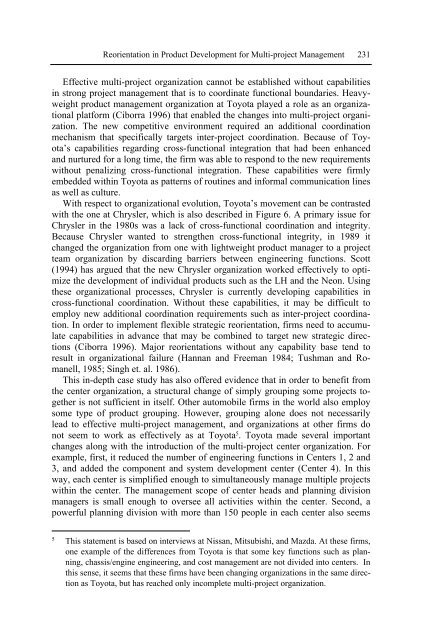Management of Technology and Innovation in Japan
Management of Technology and Innovation in Japan
Management of Technology and Innovation in Japan
You also want an ePaper? Increase the reach of your titles
YUMPU automatically turns print PDFs into web optimized ePapers that Google loves.
Reorientation <strong>in</strong> Product Development for Multi-project <strong>Management</strong> 231<br />
Effective multi-project organization cannot be established without capabilities<br />
<strong>in</strong> strong project management that is to coord<strong>in</strong>ate functional boundaries. Heavyweight<br />
product management organization at Toyota played a role as an organizational<br />
platform (Ciborra 1996) that enabled the changes <strong>in</strong>to multi-project organization.<br />
The new competitive environment required an additional coord<strong>in</strong>ation<br />
mechanism that specifically targets <strong>in</strong>ter-project coord<strong>in</strong>ation. Because <strong>of</strong> Toyota’s<br />
capabilities regard<strong>in</strong>g cross-functional <strong>in</strong>tegration that had been enhanced<br />
<strong>and</strong> nurtured for a long time, the firm was able to respond to the new requirements<br />
without penaliz<strong>in</strong>g cross-functional <strong>in</strong>tegration. These capabilities were firmly<br />
embedded with<strong>in</strong> Toyota as patterns <strong>of</strong> rout<strong>in</strong>es <strong>and</strong> <strong>in</strong>formal communication l<strong>in</strong>es<br />
as well as culture.<br />
With respect to organizational evolution, Toyota’s movement can be contrasted<br />
with the one at Chrysler, which is also described <strong>in</strong> Figure 6. A primary issue for<br />
Chrysler <strong>in</strong> the 1980s was a lack <strong>of</strong> cross-functional coord<strong>in</strong>ation <strong>and</strong> <strong>in</strong>tegrity.<br />
Because Chrysler wanted to strengthen cross-functional <strong>in</strong>tegrity, <strong>in</strong> 1989 it<br />
changed the organization from one with lightweight product manager to a project<br />
team organization by discard<strong>in</strong>g barriers between eng<strong>in</strong>eer<strong>in</strong>g functions. Scott<br />
(1994) has argued that the new Chrysler organization worked effectively to optimize<br />
the development <strong>of</strong> <strong>in</strong>dividual products such as the LH <strong>and</strong> the Neon. Us<strong>in</strong>g<br />
these organizational processes, Chrysler is currently develop<strong>in</strong>g capabilities <strong>in</strong><br />
cross-functional coord<strong>in</strong>ation. Without these capabilities, it may be difficult to<br />
employ new additional coord<strong>in</strong>ation requirements such as <strong>in</strong>ter-project coord<strong>in</strong>ation.<br />
In order to implement flexible strategic reorientation, firms need to accumulate<br />
capabilities <strong>in</strong> advance that may be comb<strong>in</strong>ed to target new strategic directions<br />
(Ciborra 1996). Major reorientations without any capability base tend to<br />
result <strong>in</strong> organizational failure (Hannan <strong>and</strong> Freeman 1984; Tushman <strong>and</strong> Romanell,<br />
1985; S<strong>in</strong>gh et. al. 1986).<br />
This <strong>in</strong>-depth case study has also <strong>of</strong>fered evidence that <strong>in</strong> order to benefit from<br />
the center organization, a structural change <strong>of</strong> simply group<strong>in</strong>g some projects together<br />
is not sufficient <strong>in</strong> itself. Other automobile firms <strong>in</strong> the world also employ<br />
some type <strong>of</strong> product group<strong>in</strong>g. However, group<strong>in</strong>g alone does not necessarily<br />
lead to effective multi-project management, <strong>and</strong> organizations at other firms do<br />
not seem to work as effectively as at Toyota 5 . Toyota made several important<br />
changes along with the <strong>in</strong>troduction <strong>of</strong> the multi-project center organization. For<br />
example, first, it reduced the number <strong>of</strong> eng<strong>in</strong>eer<strong>in</strong>g functions <strong>in</strong> Centers 1, 2 <strong>and</strong><br />
3, <strong>and</strong> added the component <strong>and</strong> system development center (Center 4). In this<br />
way, each center is simplified enough to simultaneously manage multiple projects<br />
with<strong>in</strong> the center. The management scope <strong>of</strong> center heads <strong>and</strong> plann<strong>in</strong>g division<br />
managers is small enough to oversee all activities with<strong>in</strong> the center. Second, a<br />
powerful plann<strong>in</strong>g division with more than 150 people <strong>in</strong> each center also seems<br />
5 This statement is based on <strong>in</strong>terviews at Nissan, Mitsubishi, <strong>and</strong> Mazda. At these firms,<br />
one example <strong>of</strong> the differences from Toyota is that some key functions such as plann<strong>in</strong>g,<br />
chassis/eng<strong>in</strong>e eng<strong>in</strong>eer<strong>in</strong>g, <strong>and</strong> cost management are not divided <strong>in</strong>to centers. In<br />
this sense, it seems that these firms have been chang<strong>in</strong>g organizations <strong>in</strong> the same direction<br />
as Toyota, but has reached only <strong>in</strong>complete multi-project organization.


